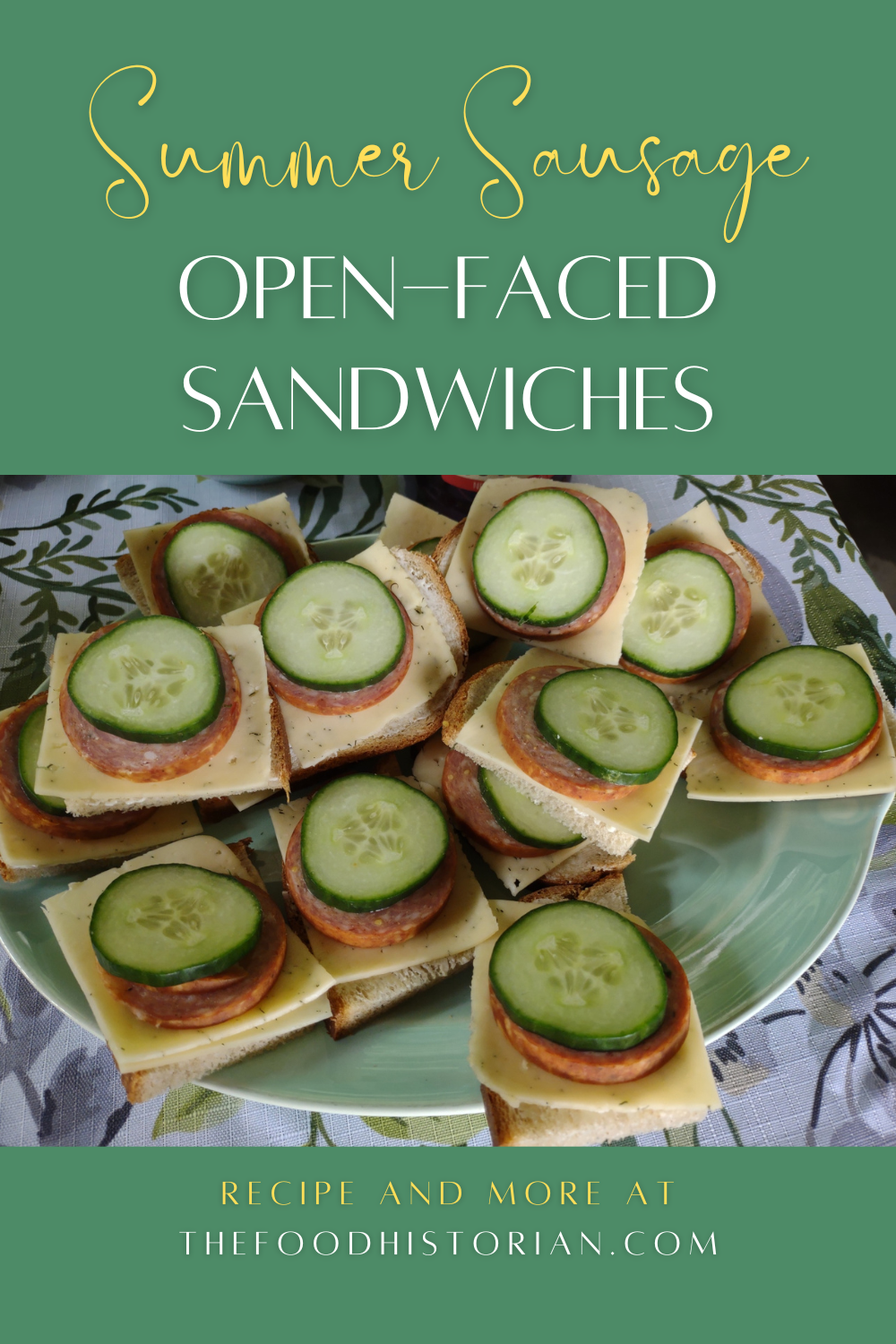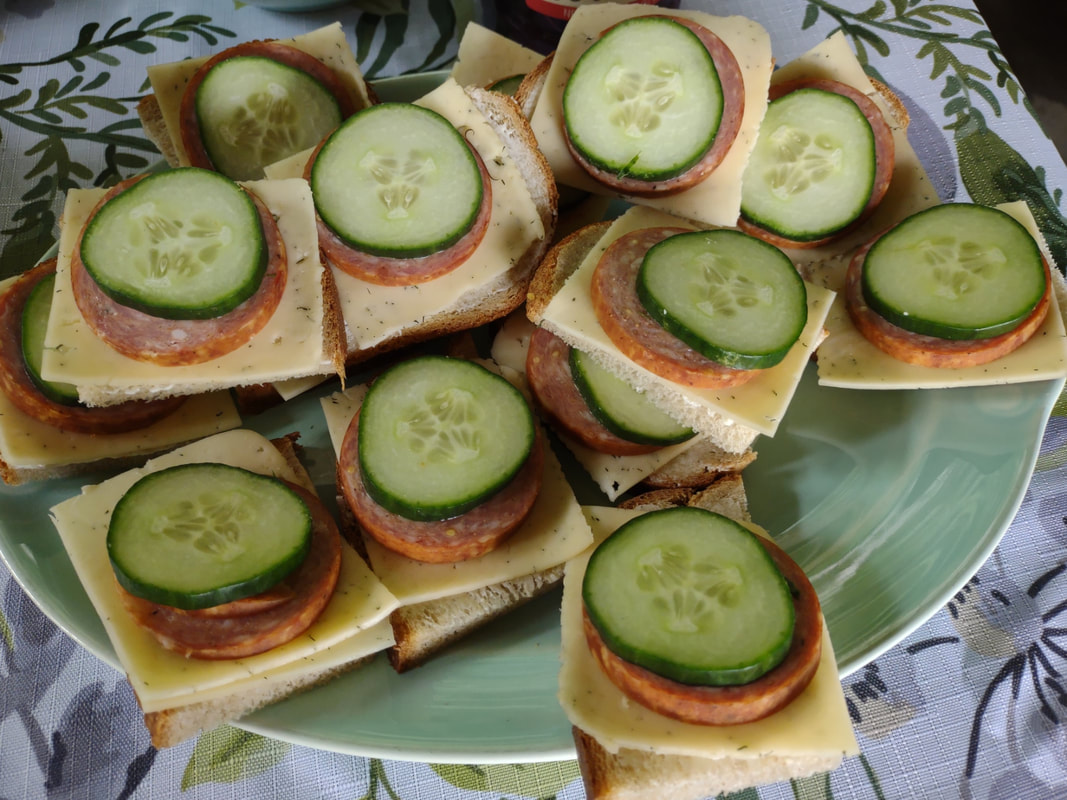|
Growing up, I considered Scandinavian-style open-faced sandwiches the epitome of style. Which, in a region where "traditional" Scandinavian food is essentially variations on meat and potatoes, it was! I requested a Scandinavian smorgasbord for my high school graduation party, and that's what I got! Of course, mine were more American than the traditional Danish versions with tiny shrimps or smoked salmon, but still delicious. When planning my Scandinavian Midsummer Porch Party, I knew I wanted open-faced sandwiches for the main dish, because they would be relatively quite and easy to assemble, and they were small enough for people to have lots. Plus! They could be served cold, so no having to manage a hot main course. The official name for open-faced sandwiches is smørrebrød, which is Danish for (literally) "butter-bread," but which is used to refer to a very specific style of open-faced sandwich. Danish smørrebrød etiquette is a bit too formal for me - eating sandwiches with a knife and fork?! No thanks. I'm Scandinavian AMERICAN, after all. And there are some very specific types of sandwiches, and even an order in which to eat them! This is a party, folks. I don't tell people how to eat unless they ask for advice. I also find the formality hilarious given the very plebian origins of open-faced sandwiches. Conventional wisdom draws a direct line from Medieval trenchers (essentially plates made of bread) to open-faced sandwiches. As with most food history, there isn't a ton of concrete evidence, but it's a logical connection. Others draw a line between 19th century field food for farmers, who ate leftovers with buttered bread for lunch. Regardless, there are some commonalities between most open-faced sandwiches. 1. Fine-grained rye bread is the best and sturdiest foundation. 2. Yes, you have to butter the bread - thinly and edge to edge. This keeps the bread structure together and prevents it from getting soggy. Buttering edge-to-edge also helps keep the bread from drying out. 3. No, it cannot have another piece of bread on top. Otherwise it's not open-faced anymore! Other than that, the sky's the limit! I made four different ones for the party, and all were a hit. Here's my personal favorite: Dill Havarti and Summer Sausage with Cucumber on RyeAt that graduation party, a variation of this was one of my favorite sandwiches my mom came up with - tiny party rye slices spread with herbed cream cheese and topped with a slice of summer sausage, a slice of cucumber, and a sprig of dill. These aren't quite the same, but equally delicious. Fine-grained rye bread, buttered Thinly sliced dill Havarti cheese 1 slice summer sausage (not salami!) 1 slice English cucumber Summer sausage is a must here. It's almost impossible to find in my neck of the woods, so when I was in Ohio for a wedding back in April, and saw giant sticks of it in the grocery store, I grabbed one to take home. It's all gone now (sadly), and it wasn't QUITE as good as the stuff from back home in North Dakota (which is known for its sausage), but it was better than anything out here in New York. Unlike dried sausages like salami or pepperoni, summer sausage is able to be kept at room temperature because of a bacteria which lowers the PH of the sausage and gives it its signature tangy taste. You have to refrigerate it once it's unsealed, but it's softer and less fatty than salami and the flavor is just as good if not better. I saw dill Havarti in the store, so had to get it for this recipe. I got mine sliced at the deli. Havarti was invented in Denmark and is an incredibly buttery-tasting, softish, lacy-grained cheese that is just lovely on sandwiches. The tender, dense rye bread, butter and buttery tasting Havarti, the tangy, salty summer sausage, and the crisp, cold cucumber are just a delicious taste sensation. I cut the bread in quarters for easier eating and to fit the sausage and cucumber better. The Food Historian blog is supported by patrons on Patreon! Patrons help keep blog posts like this one free and available to the public. Join us for awesome members-only content like free digitized cookbooks from my personal collection, e-newsletter, and even snail mail from time to time! Don't like Patreon? Leave a tip!
0 Comments
Your comment will be posted after it is approved.
Leave a Reply. |
AuthorSarah Wassberg Johnson has an MA in Public History from the University at Albany and studies early 20th century food history. Archives
July 2024
Categories
All
|



 RSS Feed
RSS Feed